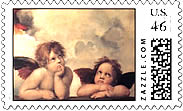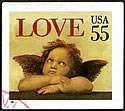Creativity,
painting, art of Raphael Santi |
|
Angels |
 |
| Raphael
Sanzio (Santi) Oil
on canvas |
| Two
angels at the bottom of the picture dispassionately look into the
distance. Their apparent indifference – a symbol of the inevitability of the adoption of the divine Providence: Christ ordained the cross, and the fate can not be changed. |
The painting’s figures consist of the Virgin Mary holding the Christ child, Saint Sixtus, and Saint Barbara who is looking down at the little cherubs whose facial expression seems to imply boredom and restlessness. They appear eager to finish their holy duties and be free to play. Regardless of their intent, they add a sense of intrigue to the scene, contrasting beautifully with the humourless miens of the figures above them. The painting was sold to Germany by the monks of the Benedictine Monastery, where it was originally displayed on the altar of the church of San Sisto in Piacenza. A
prominent element within the painting, the winged angels beneath
Mary are famous in their own right. As early as 1913 Gustav Kobbé
declared that "no cherub or group of cherubs is so famous as
the two that lean on the altar top indicated at the very bottom
of the picture." Heavily marketed, they have been featured
in stamps, postcards, T-shirts, and wrapping paper. These cherubim
have inspired legends of their own. According to a 1912 article
in Fra Magazine, when Raphael was painting the Madonna the children
of his model would come in to watch. Struck by their posture as
they did, the story goes, he added them to the painting exactly
as he saw them. Another story, recounted in 1912's St. Nicholas
Magazine, says that Raphael rather was inspired by two children
he encountered on the street when he saw them "looking wistfully
into the window of a baker's shop." |
Raphael had added the angels as an afterthought, simply to enhance the painting’s composition. By looking above, the pair seeks to pull the viewer’s eye upwards, to the Virgin and Child at the heart of the image. “They are absolutely unusual,” admits Andreas Henning. “Usually, angels would be playing music, singing, laughing and playing with the Christ Child. But there’s no painting in the world, to my knowledge, where they appear to wait in such a bored manner.” Perched on the ledge of an altar, the angels were intended to wait not only for the monks of San Sisto to celebrate mass, but for the Madonna to carry the Christ Child to Earth. Yet emptied of its religious meaning, the cherubs’ pensive appearance makes for an effective marketing tool. “It is so interesting for all the marketing experts to interpret the two angels however they want,” says Andreas Henning. “They can be waiting for a glass of prosecco, or tasting chocolate.” In the 1970s, the cherubs were transformed into the advertising darlings they are today. The pair found its way onto neckties, snow globes, Tupperware, toilet paper and air freshener. They could just as easily promote the divine pleasure of cabernet sauvignon or tiramisu, as take on the appearance of Bert and Ernie. In
fact, the angels have become so dissociated with the painting itself,
in the public mind, that the Dresden Gallery purposely sought to
reunite both in promoting the exhibit. It concentrated on images
of the Madonna herself, and chose the slogan: “The fairest
woman in the world turns 500.” Bernhard Maaz compares the
disconnect to that of the two famous hands reaching out to one another
in the Sistine Chapel’s ceiling fresco, The Creation of Adam.
“Everybody knows these two hands,” he says. “But
not everyone knows to whom they belong.” |
Cherubs in the Sistine Madonna Did you ever wonder who painted these angelic cherubs that we see so often adorning giftware, advertisements and home d?cor? Well, you may be surprised to learn that the creator of this popular motif is not a present-day artist but instead, a Renaissance painter. The winged darlings were painted around 1512 by Raphaello Salvio, otherwise known as simply Raphael, and they are only a small part of a much larger painting known as the Sistine Madonna. You can see Raphael’s Sistine Madonna, by clicking here. It is believed that the Sistine Madonna was intended to decorate the tomb of Pope Julius II. The painting features the Virgin Mary holding the Christ Child flanked by Saints Sixtus and Barbara. The two cherubs appear at the bottom of the painting. Visible only from above the neck, they lean against a horizontal balustrade. Their wings appear to be more like those of a butterfly than those of a bird. They seem calmly aware of the scene above them; their gestures indicate both expectation and patience, coupled with a benevolent innocence. But speaking of cherubs, it is hard to say if these adorable onlookers are actually cherubs in the strictest sense of the word. What I mean is that there is often confusion between cherubs, putti, angels, and cupids. Technically speaking, cherubs are angels of the second sphere, the “Cherubim.” You see, in medieval times, Christian theologians believed in an “angelic hierarchy” in which nine types of angels were grouped into three spheres, or angelic choirs. Each sphere knew God in a different way. The Cherubim are the second highest order of angels and belonged to the first sphere. They are the guardians of the light of the heavens. The Cherabim protect the throne of God and they have perfect knowledge of Him. According to Old Testament scripture, the Cherabim have four faces: man, ox, lion, and eagle. They have eight wings which are covered with eyes and they have the feet of an ox! So according to Christian theology, there are many types of angels and Cherubim are only one of these types. To make the matter even more confusing, the common “angel” is placed in the angelic hierarchy as the lowest order of angels, directly below archangels. They are the angels that are most familiar to human beings and most involved with the earthly realm. Angels were thought to have no physical form, so how were artists to portray them? Typically, artists relied on written works for guidance, primarily the Bible and the Apocrypha. But other works such as Dante’s Divine Comedy and later, Milton’s Paradise Lost provided vivid imagery of angels that was also helpful to artists. Angels of the third sphere were therefore usually portrayed as androgynous adults or non-sexual male adults. So
according to Christian theology, there are many types of angels
and Cherubim are only one of these types. To make the matter even
more confusing, the common “angel” is placed in the
angelic hierarchy as the lowest order of angels, directly below
archangels. They are the angels that are most familiar to human
beings and most involved with the earthly realm. Angels were thought
to have no physical form, so how were artists to portray them? Typically,
artists relied on written works for guidance, primarily the Bible
and the Apocrypha. But other works such as Dante’s Divine
Comedy and later, Milton’s Paradise Lost provided vivid imagery
of angels that was also helpful to artists. Angels of the third
sphere were therefore usually portrayed as androgynous adults or
non-sexual male adults. |
| |
Raphael’s
angels are widely used detail of sublime painting A flash of recognition often hits people who stop to study Raphael’s sublime painting “The Sistine Madonna.” A flash of recognition often hits people who stop to study Raphael’s sublime painting “The Sistine Madonna.” Those two angels at the bottom — they look familiar. Indeed, they’re on greeting cards, Christmas wrapping paper, feel-good postcards, souvenirs, T-shirts, even bed linens. Americans may be licking one of them on a U.S. postage stamp in the “Love” series this year.
“If
a reproduction goes to extremes, it can be difficult. It’s
like the ‘Mona Lisa.’ It’s such a widely known
image, and so often altered, that it’s no longer Though their popularity is growing in the 1990s, the images of innocence arc almost 500 years old. And they have had a life of their own for more than a century as widely reproduced illustrations — sometimes with art irreverent twist, as in a postcard that shows one of them puffing marijuana. Their passage into kitsch is a bit maddening for Gregor J.M. Weber, curator of Italian paintings in the Old Masters Paintings Gallery at the Zwinger, a 19th-century museum that helps draw a half-million tourists a year to Dresden, 120 miles south of Berlin. Weber sees the angels as a detail on* his gallery’s most famous painting. Pope Julius II commissioned the painting to be the altarpiece in the Benedictine cloister of San Sisto in Piacenza in northern Italy. The painting has been in Dresden since 1754, when it was bought by August III, prince-elector of Saxony and king of Poland, for 120,000 gold marks. It was said to be the highest price paid for any painting up to that time. |
||||||||
|
The
two angels, leaning their pudgy arms on a parapet, occupy less than
10 percent of the canvas. They are “mediators" between
the viewer and On either side kneel St. Sixtus and St. Barbara, the patrons of the Piacenza cloister. Sixtus is beckoning the Madonna and child toward the world of the viewer of the painting, and the two sacred figures are looking into the distance with serene intelligence. Extracted from the painting to stand on their own with their reddish wings, the angels could be Cupids in service of Eros. That might account for some of the ripoffs that Weber has in a collection of authorized and unauthorized reproductions of the angels. On the off-color side is a catalog offering condoms in a packet decorated with Raphael’s angels. A birth-control pamphlet from Australia has one of the angels — the especially pensive one with chin in hand — and the overline, “So you arc thinking of having a baby.” Anyone can write the museum in Dresden and ask for reproduction rights. |
The Saxony state government gets the royalties after the museum sends out a color slide and assesses a fee based on the usage. Weber doesn’t know how much Raphael’s angels earn. He
showed a letter from an American company wanting to use the angels
on magnets to hold notes on refrigerators. The company complained
the image it had been given by an agent in the United States didn't
have the angels’ wings. For
those who want to see not angelic kitsch but the entire original,
“The Sistine Madonna” will be better than ever come
January. Weber said new |
|
|
| Copyright
© 2004 abc-people.com Design and conception BeStudio © 2014-2023 |




